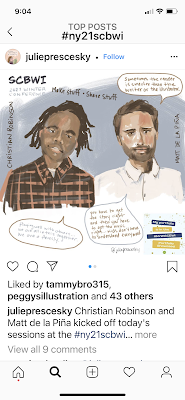There will be one winner per category and one honor book chosen. The Golden Kites serve as the kickoff event to SCBWI’s virtual conference on Friday, February 19 at 7:30pm ET/4:30pm PT. The awards are open to the public via Facebook at https://www.facebook.com/SCBWI The 2021 SCBWI Winter conference is an all virtual event that will run from February 19-21. You can find out more about the conference here.
Each winner will receive a $2,500 award along with $1,000 to contribute to a nonprofit of their choice. Each honor winner will receive a $500 award along with $250 to a nonprofit of their choice. The finalists for this year’s awards are:
Middle Grade/Young Reader Fiction
Phil Bildner:
A High Five for Glen Burke, published by Farrar, Straus and Giroux Books for Young Readers
Kimberly Brubaker Bradley:
Fighting Words, published by Dial Books for Young Readers
Leah Henderson:
The Magic in Changing Your Stars, published by Sterling Children’s Books
Pam Muñoz Ryan:
Mañanaland, published by Scholastic Press
Renée Watson:
Ways to Make Sunshine, published by Bloomsbury Children’s Books
Picture Book Text
Marsha Diane Arnold:
Lights Out, illustrated by Susan Reagan, published by Creative Editions
Derrick Barnes:
I Am Every Good Thing, illustrated by Gordon C. James, published by Nancy Paulsen Books
Tami Charles:
All Because You Matter, illustrated by Bryan Collier, published by Orchard Books
Carole Lindstrom:
We Are Water Protectors, illustrated by Michaela Goade, published by Roaring Brook Press
Phoebe Wahl:
The Blue House, published by Knopf Books for Young Readers
Nonfiction Text for Younger Readers
Gary Golio:
Dark Was the Night: Blind Willie Johnson’s Journey to the Stars, illustrated by E.B. Lewis, published by Nancy Paulsen Books
Mary Beth Leatherdale:
Terry Fox and Me, illustrated by Milan Pavlovic, published by Lee & Low"
Sandra Nickel:
Nacho’s Nachos: The Story Behind the World’s Favorite Snack, illustrated by Oliver Dominguez, published by Tundra Books
Meeg Pincus:
Winged Wonders: Solving the Monarch Migration Mystery, illustrated by Yas Imamura, published by Sleeping Bear Press
Don Tate:
William Still and His Freedom Stories: The Father of the Underground Railroad, published by Peachtree Publishing
Picture Book Illustration
Catia Chien:
The Bear and the Moon, published by Chronicle Books
Cindy Derby:
Outside In, written by Deborah Underwood, published by Abrams Books for Young Readers
Susan Gal:
Welcoming Elijah: A Passover Tale with a Tail written by Leslea Newman, published by Charlesbridge
Vincent X. Kirsch:
From Archie to Zack, published by Abrams Books for Young Readers
Jennifer K. Mann:
The Camping Trip, published by Candlewick Press
Nonfiction Text for Older Readers
Paul Fleischman:
Alphamaniacs: Builders of 26 Wonders of the Word, illustrated by Melissa Sweet, published by Candlewick Studio
Candace Fleming:
The Rise and Fall of Charles Lindberg, published by Schwartz & Wade
Cindy L. Otis:
True or False: A CIA Analyst’s Guide to Spotting Fake News, published by Feiwel & Friends
Christina Soontornvat:
All Thirteen: The Incredible Cave Rescue of the Thai Boys’ Soccer Team published by Candlewick Press
Christine Virnig:
Dung for Dinner published by Henry Holt Books for Young Readers
Illustrated Book for Older Readers
Lauren Castillo:
Our Friend Hedgehog published by Knopf Books for Young Readers
Mike Curato:
Flamer, published by Henry Holt Books for Young Readers
John Rocco:
How We Got to the Moon, published by Crown Books for Young Readers
Uri Shulevitz:
Chance: Escape from the Holocaust: Memories of a Refugee Childhood, published by Farrar, Straus and Giroux Books for Young Readers
Peter Van Den Ende:
The Wanderer, published by Levine Querido
Young Adult Fiction
Margarita Engle:
With a Star in My Hand, published by Atheneum Books for Young Readers
Darcie Little Badger:
Elatsoe, published by Levine Querido
Kelly McWilliams:
Agnes at the End of the World, published by Little Brown Books for Young Readers
Sherri L. Smith:
The Blossom and the Firefly, published by G.P. Putnam’s Sons Books for Young Readers
Nic Stone:
Dear Justyce, published by Crown Books for Young Readers
Sid Fleischman Award
Donna Barba Higuera:
Lupe Wong Won’t Dance published by Levine Querido
Remy Lai:
Fly on the Wall, published by Henry Holt Books for Young Readers
Amy Timberlake:
Skunk and Badger illustrated by Jon Klassen, published by Algonquin Young Readers
Kristin O’Donnell Tubb:
Zeus, Dog of Chaos, published by Katherine Tegen Books
Renée Watson:
Ways to Make Sunshine, published by Bloomsbury Children’s Books
Good luck to all the finalists (and that's a pretty awesome reading list for the rest of us!)
Illustrate and Write On,
Lee























